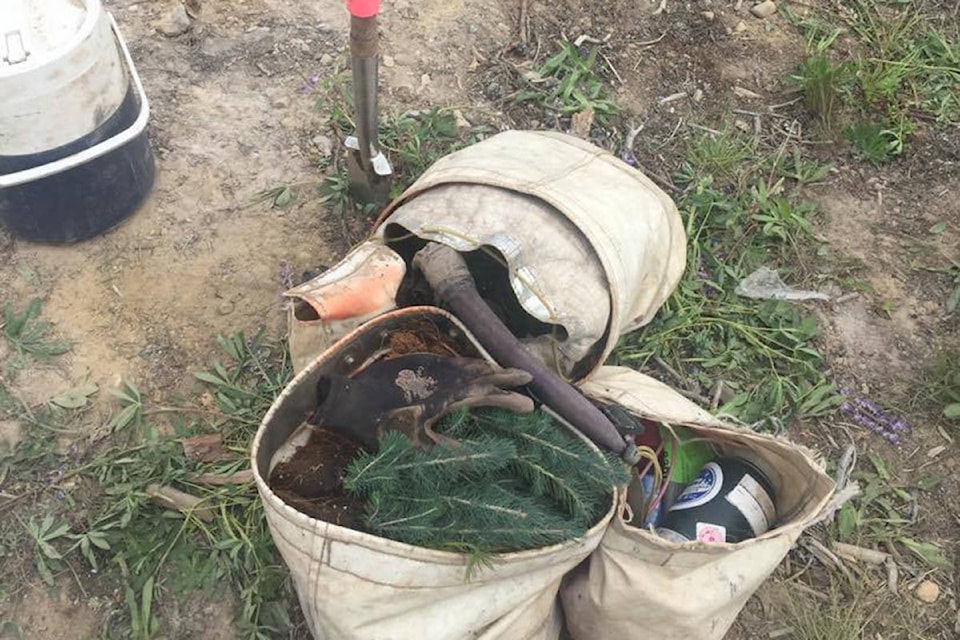Forested areas of the Cariboo Chilcotin devastated by wildfires in 2017 and 2010 are the focus of continued replanting efforts under the Forest Carbon Initiative.
Bill Layton, a registered professional forester with Zanzibar Holdings Ltd. in 100 Mile House, said 7.3 million trees will be planted predominantly in the 2017 Hanceville fire area and some in the 2010 Dog Creek fire.
A total of 36 million trees are being planted over a three-year program between 2020 and 2022.
In 2019 some planting was done at an experimental level with different techniques, and 2020 was the first big year.
There are a total of six contractors working on the project and over 200 tree planters, plus 30 to 40 supervisors and people running trees.
Planting areas within the Hanceville fire are in Yunesit’in First Nation territory and Layton said crews from the community are doing quality checks on the planting, layout and traversing support.
“We are putting together a training program with Yunesit’in to get more people out doing planting and hopefully other types of activities once the planting is done,” Layton said.
Trina Setah, Nenqay Manager for Yunesit’in (lands, water and resources), said aside from reforestation, the community is also planning for wildfire mitigation projects, landscape revitalization and ecosystem restoration.
“These pilot projects we are doing have the potential to grow and gain momentum,” Setah said, noting the community just completed a successful prescribed burn working with the BC Wildfire Service.
Setah will also be looking at some species-at-risk, access and roads projects.
In the role since September 2020, Setah said COVID-19 measures implemented last year will be in place again.
“The Western Forestry Contractors Association has done a great job of putting together camp rules. The only difference this year is there are testing kits available.”
When planters arrive at a camp or a town they do preliminary screening to ensure everyone has done the self-isolation they are supposed to do before they arrive.
If something shows up with the testing kit then the planter will go into have a COVID-19 test done.
In 2020 no one tested positive for the virus in B.C. amidst all the tree planting crews.
Species being planted in the fire-damaged areas include Douglas-fir, lodgepole pine, ponderosa pine, spruce and some aspen.
When asked how last year’s planting did, Layton said “generally really good.”
“I am happy with what I have seen so far. We are planting in some really difficult sites and the climate out there is very challenging to get trees established because it is a very short window that does not have frost and there tends to be a lot of drought in summer, even in a wet year.”
Guy Burdikin, Cariboo Carbon Solutions project forester, said roughly 65 to 70 per cent of the sites have been prepared mechanically, using a sub-soiling ripping tooth on a D8 bulldozer.
It breaks the fracture in the soil, provides opportunity for root growth, moisture transfer and grass competition.
“Douglas-fir is extremely difficult to reforest within these stand types, especially fires. Our survival is good but we are always working to do better because it’s a difficult species to generate, even in the wet belt like east of Williams Lake.”
It is a bit of a risk, but worth taking, he added, noting they try to site prep wherever they can based on the amount of funding and the condition of the site.
Burdikin said there were parts of the Hanceville area that were impacted with the highest fire intensity and severity.
“These stands are completely burnt and that’s why they cannot regenerate naturally. Someone has to be there to reforest them or they would just revert to grass and take 25 to 30 years to regenerate through slow seed creep over time,” he said. “It’s very vital work if B.C. wants to see these sites reforested.”
Layton said there has been little rain since spring began, not much snow this winter and any snow there was disappeared quickly.
The planting started a week earlier overall this year than last year, and should mostly be completed by the end of May.
“It is quite excellerated over last year. Last year with the COVID scramble it put everybody behind and we wound up going into the end of July, but that is not going to happen this year,” Layton said.
Read more: B.C. tree planting season ramping up with COVID-19 measures in place
Read more: No reported COVID-19 transmission in B.C.’s tree planting spring/summer effort
news@wltribune.com
Like us on Facebook and follow us on Twitter
